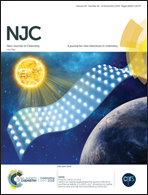Bimetallic Co/Al nanoparticles in an ionic liquid: synthesis and application in alkyne hydrogenation†
Abstract
Herein, we report the microwave-induced decomposition of various organometallic cobalt and aluminum precursors in an ionic liquid (IL), 1-butyl-3-methylimidazolium bis(trifluoromethylsulfonyl)imide ([BMIm]NTf2), resulting in Co/Al nanoalloys with different molar Co/Al ratios. The dual-source precursor system of dicobalt octacarbonyl (Co2(CO)8) and pentamethylcyclopentadienyl aluminum ([AlCp*]4) in [BMIm]NTf2 afforded CoAl nanoparticles (CoAl-NPs) with a molar Co/Al ratio of 1 : 1. Their size and size distribution were determined via transmission electron microscopy (TEM) to be an average diameter of 3.0 ± 0.5 nm. Furthermore, the dual-source precursor system of cobalt amidinate ([Co(iPr2-MeAMD)2]) and aluminum amidinate [Me2Al(iPr2-MeAMD)] in molar ratios of 1 : 1 and 3 : 1 resulted in CoAl- and Co3Al-NPs with an average diameter of 3 ± 1 and 2.0 ± 0.2 nm, respectively. All the obtained materials were characterized via TEM, energy dispersive X-ray spectroscopy (EDX), selected area electron diffraction (SAED), together with high-angle annular dark-field scanning transmission electron microscopy (HAADF-STEM) and (high-resolution) X-ray photoelectron spectroscopy ((HR-)XPS). Phase-pure Co/Al-NPs were not obtained since the concomitant formation of Co-NPs and Al2O3 occurred in this wet-chemical synthesis. The as-prepared Co/Al nanoalloys were evaluated as catalysts in the hydrogenation of phenylacetylene under mild conditions (2 bar H2, 30 °C in THF). In comparison to the monometallic Co-NPs, the Co/Al-NPs showed a significantly higher catalytic hydrogenation activity. The Co- and Co/Al-NPs were also active under harsher reaction conditions (80 bar H2, 80 °C) without the addition of the activating co-catalyst DIBAL-H.



 Please wait while we load your content...
Please wait while we load your content...